The Harms of Traditional Mosquito Spraying

The biggest mosquito control companies unfortunately still use the traditional “barrier spray” methods for mosquito control. Not only is this ineffective, but it is actively harmful to beneficial insects in your yard. These companies are largely spraying broad spectrum insecticides, mostly pyrethroids, that kill most insects in your yard. This includes the beneficial insects that pollinate your veggie garden, defend your perennials from pests, and feed the birds you’ve worked hard to attract to your yard.
If your yard is smaller than an acre, a large portion of mosquitos you see in your yard are coming from neighboring yards. A barrier spray doesn’t have any impact on mosquitos outside your yard, they can just come right over. There is no “barrier.” Our baiting station system is the only product on the market we’re aware of that can actually impact breeding sites outside of your property, using the innovative auto-dissemination approach developed by In2Care. Additionally, because many of these companies don’t apply a larvicide, new mosquitos can emerge from within the yard mere days after the yard is sprayed.
One of the biggest issues with traditional mosquito control “barrier spray” treatments is the application method: spraying. Spraying inevitably results in spray drift, presents a risk of inhalation to humans and animals, and coats insects and surfaces insects will land on. This harms those insects whether they were targets of the spray or not. There are some pesticides that we would endorse as safe if used responsibly, and that we even use ourselves, that would be hugely detrimental if sprayed all over your yard. That is why Bee-Safe Mosquito Control is strictly no spray.
We’ve managed to get a list of pesticides used by two of the biggest mosquito control companies in the DMV. Below are the specific chemicals they use in yards in your neighborhood. We won’t name names, but they’re both national franchises with hundreds of locations throughout the US. The ecosystem is in crisis due to habitat loss, pesticide use, invasive species, and pollution. These companies are contributing to that problem, and we will use this space to show you exactly how they are damaging the ecosystem, regardless of what they may claim. We hope these companies will join Bee-Safe in going no-spray and adopting better practices.
Adulticides: The Worst Offenders
Fendona-CS (EPA Reg. #499-570)
Active Ingredient: Alpha-cypermethrin
Fendona-CS uses a broad spectrum pyrethroid insecticide to kill adult mosquitos. Unfortunately, it kills nearly every insect, arachnid, and possibly other invertebrates. You don’t have to look much further than the label for proof, but yet, these national mosquito control chains claim it is safe anyway. It literally says it kills bees on the label. These excerpts come directly from the label, which is linked above.

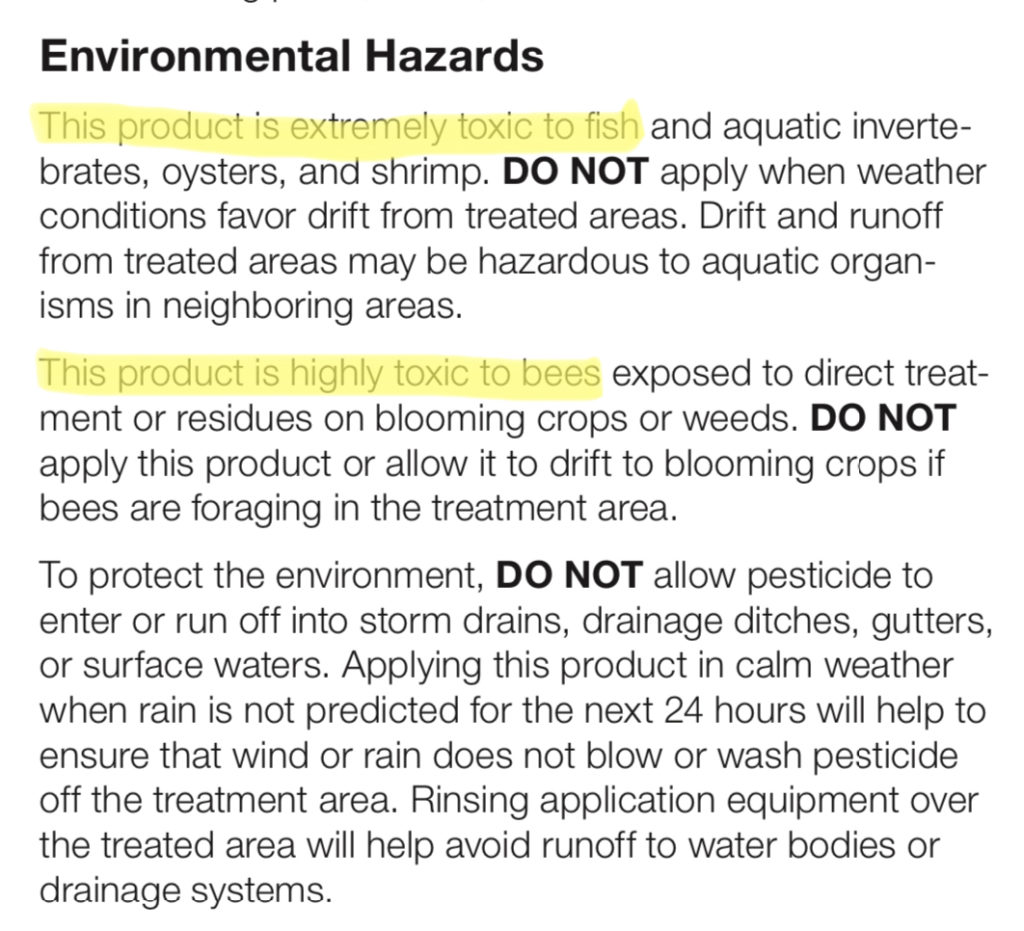
Tempo SC (EPA Reg. #432-1363)
Active Ingredient: Beta-cyfluthrin
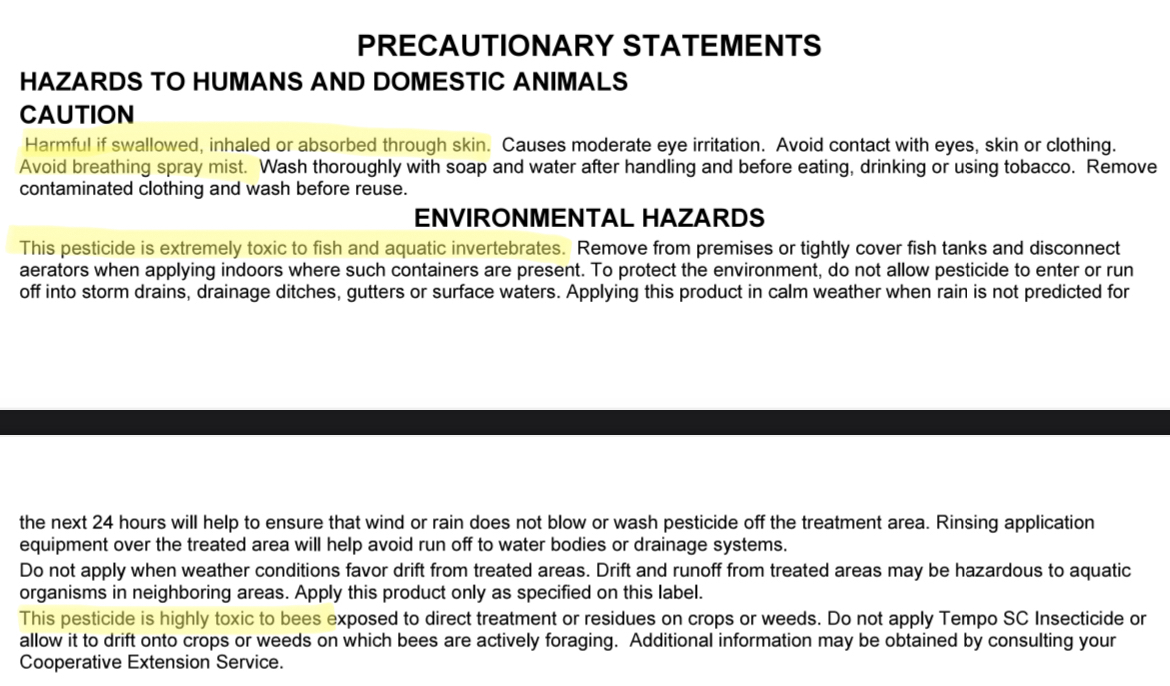

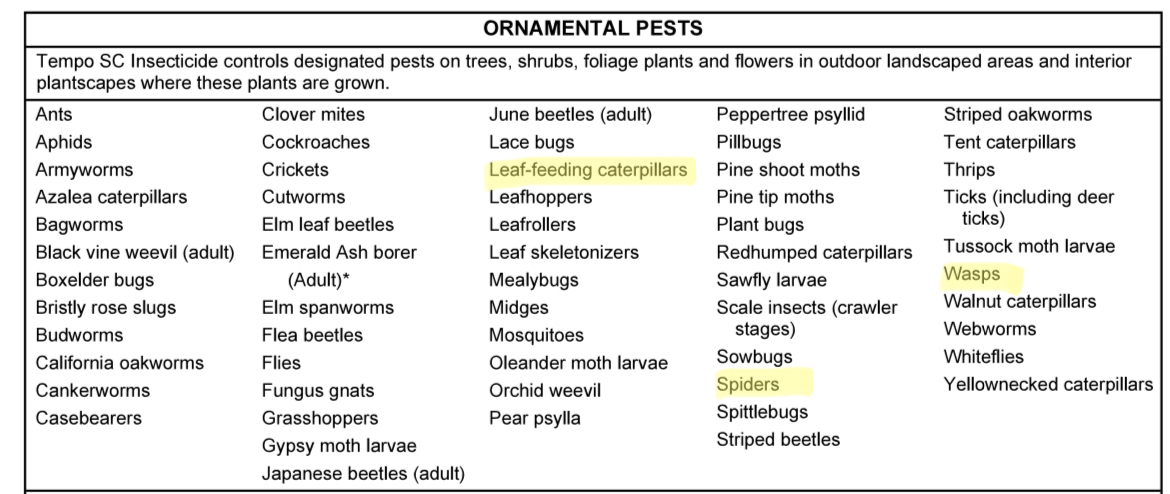
Bifenthrin PL (EPA Reg. #53883-124)
Active Ingredient: Bifenthrin
But, that doesn’t change the fact that this will undoubtedly harm insects on the ground when the applicator waters it in and the granules dissolve Bifenthrin into the water, which spreads to cover the ground. According to the Xerces Society(source), approximately 70% of native bee species nest in the ground! Obviously, given the toxicity of Bifenthrin to bees, using this product would be hugely detrimental to native bees and probably most other insects and arachnids that live in or walk on the ground.
Bifenthrin is also a PFAS chemical, also known as a forever chemical. It was designed to have longer residual impact, and they did that by fluorinating it. Bifenthrin is a known carcinogen.
Cyzmic CS (EPA Reg. # 53883-261)
Active Ingredient: Lambda-cyhalothrin
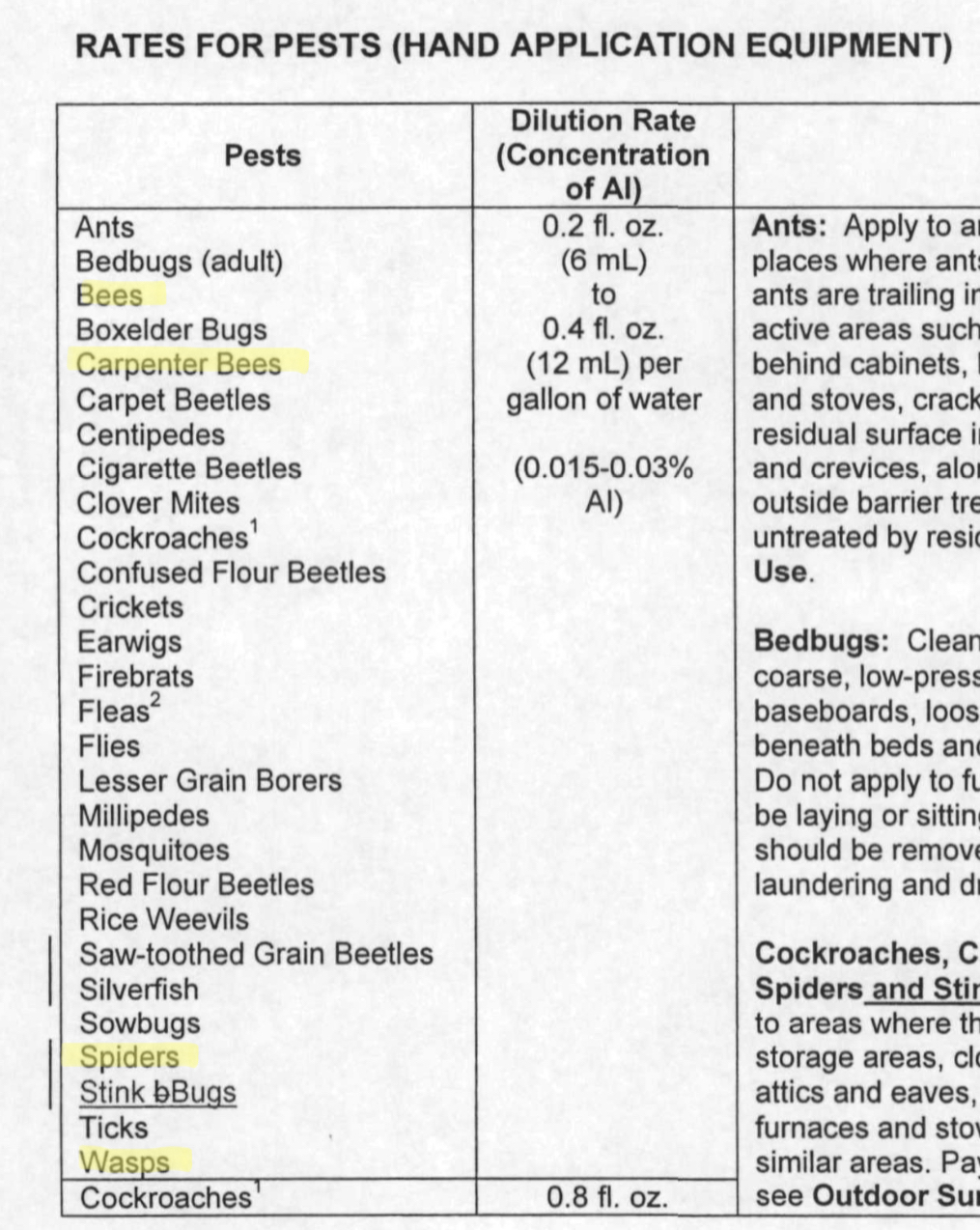

DuraFlex (EPA Reg. #53883-426)
Active Ingredients: Bifenthrin, novaluron, pyriproxyfen
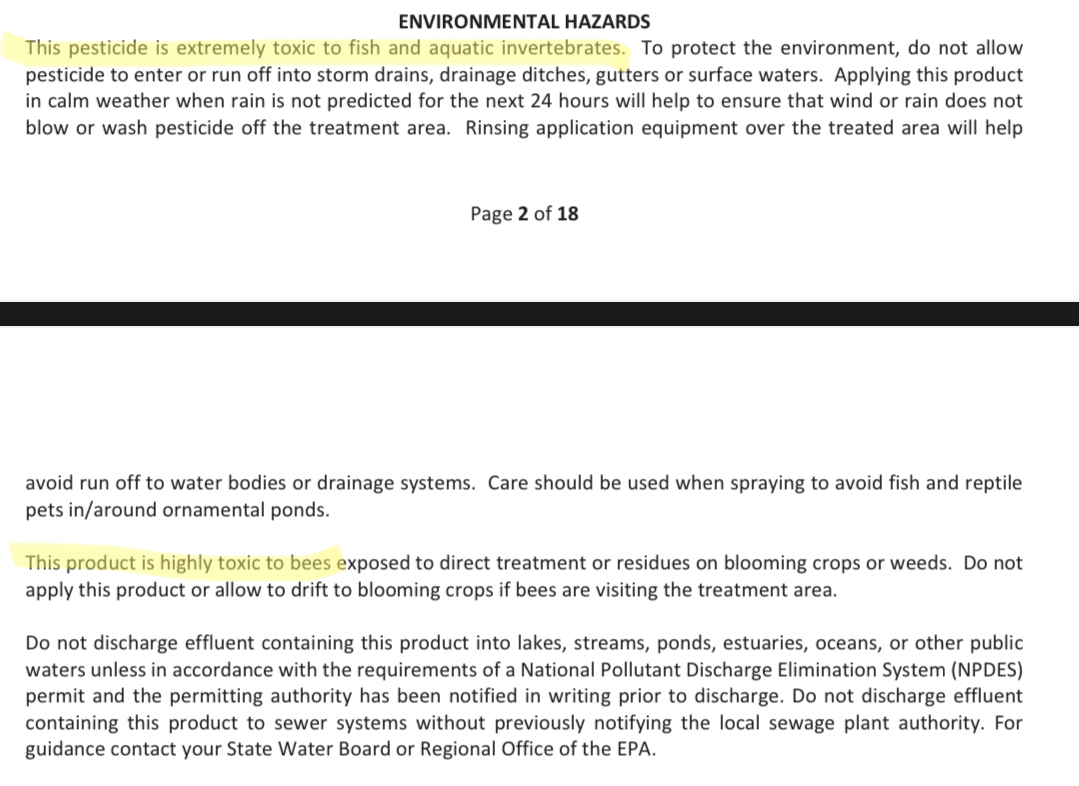

Stryker (EPA Reg. #53883-308)
Active Ingredients: Pyrethrins, piperonyl butoxide
So, we’ve reached the end of the adulticides and we have all broad spectrum Pyrethroids and Pyrethrins. All of them from the same family of insecticides. Traditional mosquito control companies apparently have no originality, but more importantly, they apparently do not care at all about pesticide resistance. Mosquitos have already been documented to have developed resistance to this class of insecticides. Alarmingly, the prolific disease vector Aedes Aegypti seems particularly adept at developing pyrethroid resistance. The USDA conducted a study in Florida and found that 20 out of 20 Aedes Aegypti strains collected throughout the state were resistant (source). It is reckless for mosquito control companies to continuously apply the same class of insecticides to treat mosquitos, when it has been shown both in the US and around the world that mosquitos are developing resistance. So not only are the national franchise mosquito control companies killing beneficial insects, but their treatments are becoming less effective on mosquitos! This is yet another reason to target at the larval stage. Bee-Safe’s baiting stations use 2 active ingredients that are from completely different classes, so you won’t have to worry about pesticide resistance with our system.
We do see a new active ingredient, piperonyl butoxide. It’s a synergist, meaning it isn’t intended to kill insects by itself, rather it improves the effectiveness of the adulticide. But, it’s still not going to prevent pesticide resistance. It’s often paired with Pyrethrins or Pyrethroids, and it’s definitely less harmful than both, so it’s not worth much discussion.
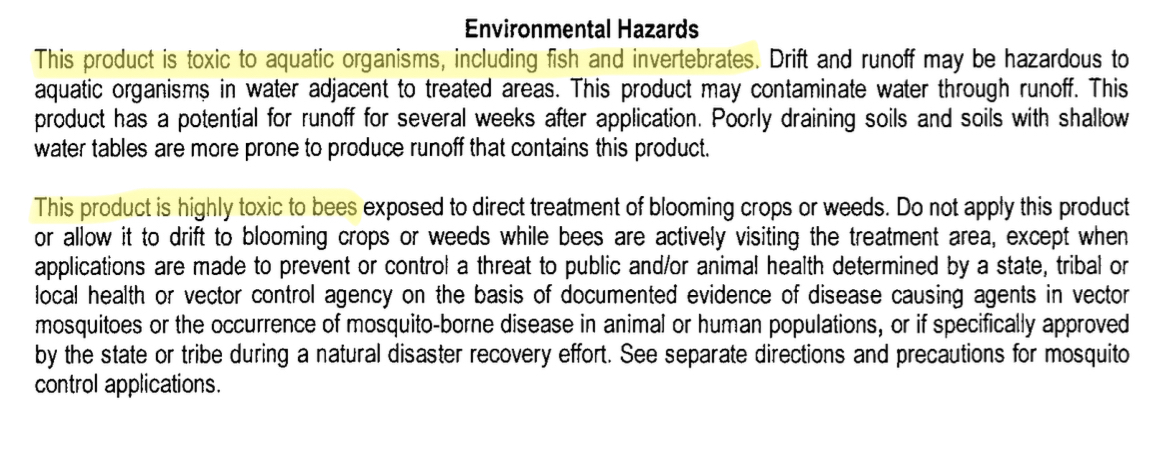
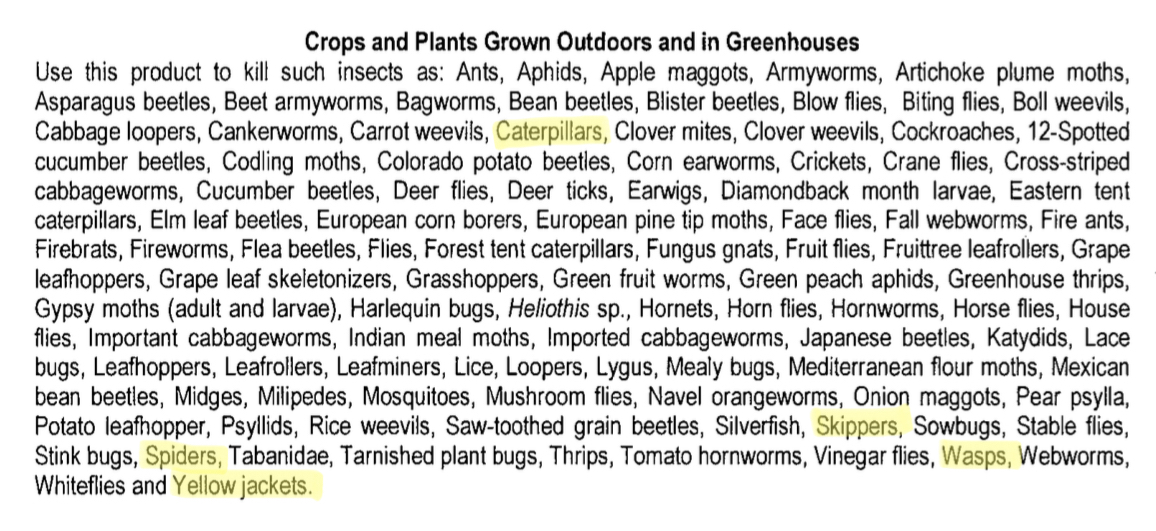
Larvicides: Sounds Better…But Are They Safe?
Altosid WXRG (EPA Reg. #89459-104)
Active Ingredient: Methoprene
Methoprene is an insect growth regulator that’s mode of action is to prevent metamorphosis from progressing in insects. While Methoprene is widely regarded as safe for humans and other vertebrates, the same cannot be said for invertebrates. Thankfully, Methoprene is not considered toxic for bees, though that can’t be said definitively for bee larva. However, Methoprene has been shown to be toxic to several species of Lepidoptera (butterflies and moths) and is considered a broad spectrum insecticide (source). Used in a granular form applied directly to standing water that poses no risk of runoff, Methoprene is likely a safe larvicide to use. However, granules spread across an entire property or sprayed would likely cause death and other sub lethal effects on Lepidoptera populations, particularly the eggs and larva.
Tekko Pro (EPA Reg. #53883-335)
Active Ingredients: Novaluron, Pyriproxyfen
The “Green” Options: We Wish Natural Meant Safe
Ecovia G (Label)
Active Ingredients: Thyme Oil, Clove Oil, Lemongrass Oil, Rosemary Oil
Ecovia MT (Label)
Active Ingredients: Soybean Oil, Clove Oil, Citronella Oil, 2-phenylethel propionate, Lemongrass Oil
Stop The Bites (Label)
Active Ingredients: Castor Oil, Lemongrass Oil, Geraniol, Cedarwood Oil, Sodium Laurel Sulfate, Corn Oil
All 3 of these products claim to actually kill (rather than just repel) mosquitos and other pests. Since they have lots of ingredients in common, we will go ingredient by ingredient and assess the safety and efficacy. One important difference is Ecovia G is a granular product rather than a spray, which generally does make it less damaging to beneficial insects. Many gardeners will be familiar with horticultural oil, neem oil, etc. Spraying oils on insects can have the effect of preventing them from breathing, which is how those products work for gardening purposes. This is why spraying oils all over your yard, natural or otherwise, can be inherently damaging. Remember, natural does not always equal safe! Some well known substances derived from plants that most people wouldn’t consider safe: cocaine, opiates, ricin, cyanide…
Lemongrass Oil
Lemongrass oil is found in all 3 products above, and is considered a broad spectrum insecticide and repellent. Unfortunately there isn’t a ton of research on its toxicity to various insects. But, we do know that it is effective as an insecticide against at least one Coleoptera (beetle) species(source), as well as at least one Lepidoptera(butterfly/moth) species(source). We also know that for honeybees it can serve as an attractant(source), while for at least 2 species of wasps, it serves as a repellant (source). Depending on your goals, repelling wasps may be a pro or a con for you. However, it is likely that lemongrass oil is able to cause mortality in other Coleoptera and Lepidoptera species, probably including important pollinators. So for that reason, we wouldn’t recommend spraying a large portion of your yard with lemongrass oil.
Clove Oil
There is very very little research on the impact of clove oil on most groups of insects. The little research that has been done would seem to suggest that bees and Lepidoptera would not be harmed by it. The research does seem to show that it acts as a repellent for seemingly all insects. There are some insects that have been shown to be susceptible to it. While clove oil has performed well as a repellent of mosquitos compared to other essential oils, its performance is unfortunately measured in hours rather than days or weeks (source). In our opinion, clove oil has not shown enough effectiveness to justify covering a yard in it without more data on the impact it has on a variety of insect species. It is perhaps best used as a topical repellent.
Castor Oil
Like many other active ingredients in this category, there just isn’t enough research. There is evidence that castor oil is effective at killing mosquito larva and adults (source). The issue is, there is also evidence that castor oil is effective against the larval stage of at least one Lepidoptera species (source). It is not clear if there have been any studies on toxicity for bees. Due to the potential effect on beneficial Lepidoptera (butterfly/moth) species, we cannot recommend using castor oil in a spray, as caterpillars would likely be present in the same areas that would be sprayed for mosquitos.
Cedarwood Oil
Again, not a lot of research. No definitive research on bees could be found but it is believed to be safe for bees. It was found to cause mortality in 2 Coleoptera (beetle) species and 1 Lepidoptera (butterfly/moth) species (source). It is likely that it would then be toxic to other species within those groups as well, potentially including beneficial pollinators. Cedarwood Oil was also found to be ineffective at repelling mosquitos (source). Therefore, we would not recommend using it as a spray.
Corn Oil
Corn oil’s mode of action is similar to that of horticultural oil products used commonly in gardening. It essentially smothers and suffocates the insect by blocking air exchange. Because this mode of action suggests effectiveness against a wide range of insects, we would consider it a broad spectrum insecticide. It has been shown to cause mortality in at least one Coleoptera (beetle) species(source) and is thus likely to affect others, potentially including beneficial pollinators. It has also been shown to cause mortality in at least one Lepidoptera (butterfly/moth) species (source). There does not appear to be any research on the effect on bees, though it is likely that any bee hit directly by the spray would be impacted. Because of the potential risks to beneficial Coleoptera and Lepidoptera, we would not recommend using corn oil as a spray.
Citronella Oil and Geraniol
These are grouped together because geraniol is a major component of citronella oil, which is an essential oil derived from the Java citronella plant, a close relative of the lemongrass plant. At high concentrations it can be effective at repelling mosquitos, primarily by masking the scents mosquitos use to target you. This effect, however, is short lived, on the scale of hours rather than weeks. At high concentrations and application rates, citronella oil has been found to be effective at killing mosquitos. However to be an effective method of control, it would have to be much longer acting than it is, since it is targeting the adult stage. It is likely that citronella oil at this high of a concentration and application rate would be damaging to non-target insects since it is applied as a spray and is an oil. There has not been much study on what this impact would be. Given that the impact in repelling or killing mosquitos is so short, and given the potential risk to non-target insects, spraying citronella oil widely across a yard is not recommended. Citronella candles generally do not produce enough of a repellent effect to have a significant effect (source).
2-Phenylethel Propionate
There has been very little study on this chemical. However, it is primarily used as an insect attractant for baited traps, specifically for beetles. It is not clear why this would be included in a mosquito spray product. It is not believed to be effective at killing insects and is usually combined with another insecticide (source).
Sodium Lauryl Sulfate
You likely recognize this one from your bottle of shampoo. It is used extensively in commercial products, and thus is likely safe for humans. It is a surfactant, and its use as a pesticide is typically in flea and tick shampoos. There is very little research on its effectiveness against other insects, including adult mosquitos and all of the many beneficial insects. Applied directly to mosquito breeding habitat, its behavior as a surfactant can cause larval mosquito mortality. (source). It’s likely used in a low enough concentration in a spray formulation that it effectively does nothing to adult mosquitos, but, if it were at a high enough concentration to kill adult mosquitos, given that it also kills fleas and ticks, it is likely it would be very broad spectrum and detrimental to beneficial insects if used in a spray formulation.
Soybean Oil
Soybean Oil has not been shown to be effective as a mosquito repellent at all, despite its presence in mosquito repellant products (source). It is yet another plant derived oil that’s only plausible mode of action, like the horticultural oil you may use on spider mites, is to suffocate the insect. This is by its very nature broad spectrum when applied as a spray to large portions of a yard.
Rosemary Oil
Rosemary oil has been found to be an effective repellent in high concentrations. However, its effectiveness is measured in just hours, approximately 8 hours (source). I couldn’t locate any studies showing it would actually kill mosquitos, but it would be the same mode of action as other oils, as mentioned many times on this page. I wouldn’t recommend using rosemary oil, just as I wouldn’t recommend any of the other essential oils on this list.
Thyme Oil
Yet another essential oil. Thyme oil is regarded as one of the most effective essential oils for repelling mosquitos, but again, it is effective for mere hours rather than days or weeks. It has shown some insecticidal activity, especially against mites (source). Given that it was effective against mites and not against honeybees, it is likely the mode of action was smothering/suffocation, just like a horticultural oil used on aphids and spider mites. Given this, it is either unlikely to kill adult mosquitos because of too small of a concentration or too fine of a droplet size, or it is likely to kill a wide diversity of insects without being very specific to mosquitos.
